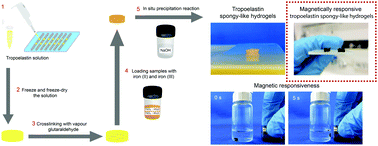Engineering magnetically responsive tropoelastin spongy-like hydrogels for soft tissue regeneration†
Abstract
Magnetic biomaterials are a key focus in medical research. Tropoelastin is the soluble precursor of elastin and is a critical component of tissues requiring elasticity as part of their physiological function. By utilising the versatility of tropoelastin and the ability to tailor its properties, we developed a novel magnetic spongy-like hydrogel based on tropoelastin doped with magnetic properties by in situ precipitation method. The presence of magnetic nanoparticles altered the secondary structure of tropoelastin. Bioengineered tropoelastin-based magnetic spongy-like hydrogels displayed a homogenous distribution of magnetic nanoparticles throughout the tropoelastin network and quick magnetic responsiveness to an applied external magnetic field. Morphologically, in the presence of magnetic nanoparticles, hydrated tropoelastin spongy-like hydrogels showed apparently smaller pore sizes and less swelling. Furthermore, in vitro biological studies using human tendon-derived cells revealed that magnetically responsive tropoelastin spongy-like hydrogels supported cell viability and enabled cell adhesion, spreading and migration into the interior of the spongy-like hydrogel up to two weeks. The bioengineered tropoelastin-based magnetic spongy-like hydrogel represents a novel class of hybrid biomaterial that can serve as a platform for soft tissue regeneration.



 Please wait while we load your content...
Please wait while we load your content...